Microsoft BUILD: Windows 8, A Pre-Beta Preview
by Brian Klug & Ryan Smith on September 13, 2011 12:05 PM EST- Posted in
- BUILD
- Windows
- Microsoft
- Windows 8
- Trade Shows
Mobile Experience Side
Coming from the smartphone side of things, I really see many shades of WP7 inside Windows 8. That’s actually dramatically understating the state of things - the core of what we’ve been shown of Windows 8 that’s new literally is either adopted from or directly analogous to much of WP7.
It doesn’t come as a surprise to me at all that the desktop Windows experience is moving in this direction, (and it seems as though the Xbox 360 interface will follow shortly). The positive result is that Windows 8’s touch experience feels much closer to the ground-up approach Android Honeycomb or iOS have taken than the than the “Tablet-Edition” versions of Windows XP and the tablet integration in Vista and 7. I used a UMPC and remember Origami and how that application lived as its own standalone mode of operation as an application within windows. What Windows 8 is the inverse - Windows now lives inside a Metro-themed Start screen that looks like WP7 for the desktop. Or at least it does in this demo we’ve been shown currently.
The tablet experience is now absolutely on par with modern mobile OSes - sure there are a few more things that need to be included, but the foundation is there for Windows to suddenly become more than an OS that also can do touch-based interaction.
IE 10
Microsoft has been actively promoting IE 10 since MIX 11, with two platform previews so far, and IE 10 is an integral part of Windows 8 both as a browser and as a runtime for HTML based Metro applications. We won’t go into exacting detail about what’s new and interesting inside IE10, beyond mentioning that it improves upon IE 9’s GPU acceleration and improves web compliance support including CSS3. What’s relevant in Windows 8 is that IE 10 gets two views - one belonging to the Metro-heavy start menu experience, which we’ll call the mobile view, and the other belonging to the traditional desktop windows view.
This dichotomy exists between the two IE10 experiences, which is in itself a bit curious. The mobile view is almost exactly what IE looks like inside Windows Phone 7.5 - at the bottom is the URL bar and controls, and with a slide down gesture, at the top are tabs. Meanwhile the IE10 desktop experience uses the older IE 9 UI. At this point, it doesn’t appear that windows opened in one are transportable to the other.
The mobile view is almost exactly like WP7.5’s however, the URL bar disappears when scrolling, and the browser supports a completely fluid multitouch experience that feels speedy.
Cloud
Windows 8 offers considerable integration with Windows Live and SkyDrive. Local user accounts can be directly tied to a Live account on trusted PCs, and then be used for live roaming. Live roaming enables each connected device to access the same set of accounts for photos, email, calendar, and contacts and speed up initial setup. For example, photos captured on a WP7.5 device’s camera roll can be immediately visible on a Windows 8 PC authenticated against the same Live account. This is very close to how camera roll will integrate into Apple’s iCloud and synchronize across iOS and OS X Lion.
One thing is clear, and it’s that Microsoft plans to heavily integrate and leverage its Live services into Windows 8 and provide an ecosystem-wide way to migrate accounts settings, photos, and data between mobile, tablet, and desktop.
Samsung’s Reference Tablet
We’ve been loaned Samsung tablets running the Windows 8 Evaluation copy used for this article, and thought it bears going over since the device will no doubt become a reference platform for Windows 8 development. This hardware is also being given away to developers in attendance at BUILD as well.
The Samsung tablet is none other than the 700T model announced at IFA very recently, and it packs a relatively impressive spec list.
| Samsung 700T Windows 8 Development Notebook/Slate - Specifications | |
| Processor |
Intel Core i5-2467M (2x1.6GHz + HT, 32nm, 3MB L3, 2.3GHz Turbo, 17W) |
| Chipset | Intel 6 series |
| Memory | 4 GB DDR3 1333MHz RAM (1 SODIMM) |
| Graphics | Intel HD 3000 |
| Display | 11.6" Super PLS (1366x768) |
| Hard Drive | 64 GB Samsung SSD |
| Networking | 802.11n WiFi + Gigabit Ethernet + GSM/WCDMA HSPA+ |
| Sensors | NFC, Magenetometer, Accelerometer, GPS, ALS, Front, Rear Camera |
| Dimensions | 12.9 mm thick, 909 grams |
The 700T includes GSM/WCDMA cellular connectivity courtesy of an Option GTM661W combination cellular modem and WiFi card. The GTM661W uses a Qualcomm MDM6200 baseband, which also provides GPS. There are also sensors such as ambient light, an accelerometer, and the two cameras onboard.
In addition, the 700T includes an active digitizer and capacitive touch display, making it suited for all three interaction modes that Windows 8 will support. The device comes with a dock that doubles as a charging stand, and also replicates full size HDMI, GigE, and a USB 2.0 port on the back. The slate has one USB 2.0 port, a headphone jack, microSD card slot, SIM slot, and a rotation lock button.
Samsung calls the 700T a slate, we've elected to call it a tablet, and the device feels decent if not a bit heavy in the hands. The 700T is also the first 16:9 tablet we've seen, with Android adopting 16:10 and iOS going with 4:3, which makes portrait a bit extreme.


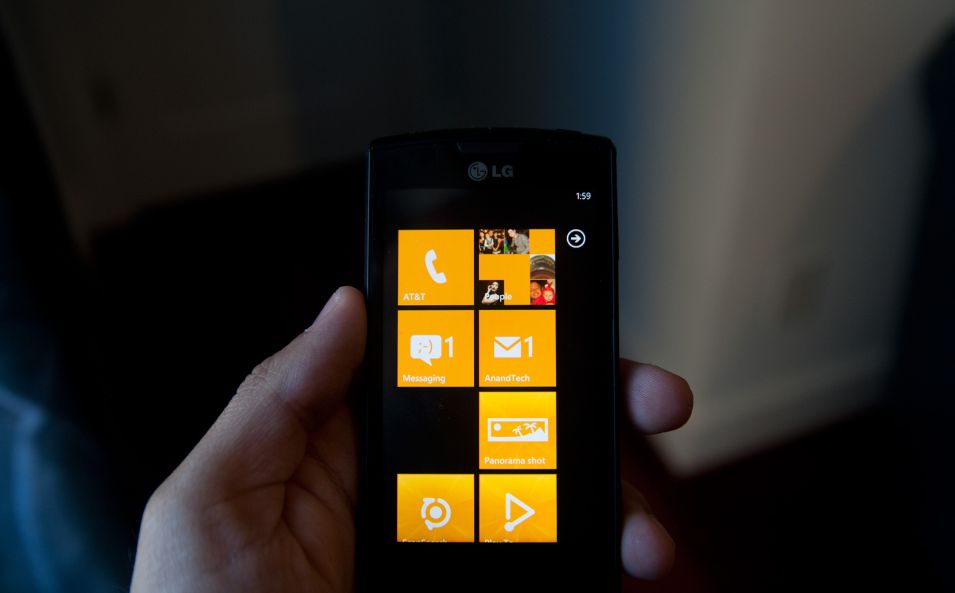
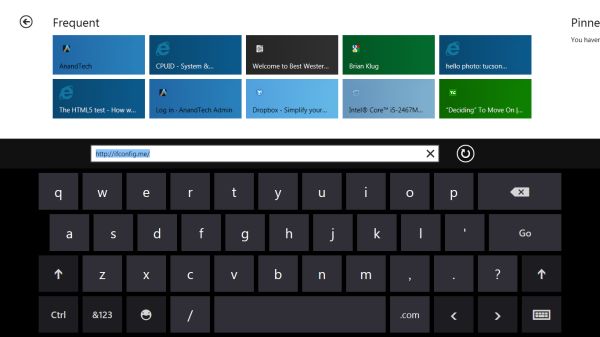
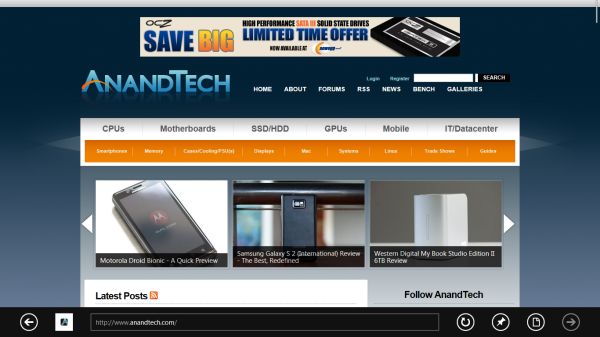
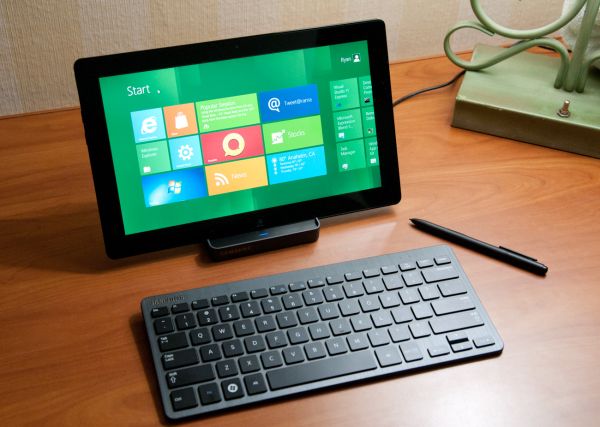
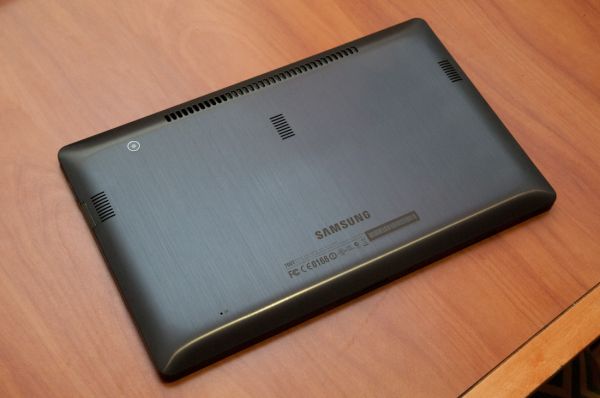
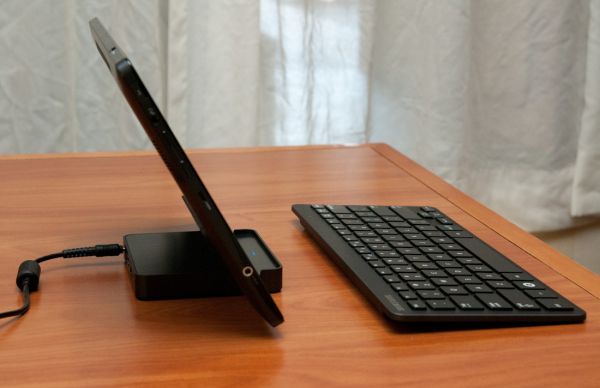








235 Comments
View All Comments
UMADBRO - Tuesday, September 13, 2011 - link
Thankfully, I dont agree. Im actually going to give it a shot before I completely make up my mind about it. Maybe you should too.martin5000 - Wednesday, September 14, 2011 - link
I said I trying to like it, i.e. I haven't finished concluding my opinion of it. The problem is that every detail of metro I've seen so far is very disappointing.cfaalm - Wednesday, September 14, 2011 - link
I don't hate it. IIt just hasn't sunk into mee how this will be usefull for a deskttop, especially with professional applications that mostly require the whole screen, and want to run without much else going on. We need to know if we can tone it down and shut some of that stuff off.SteelCity1981 - Thursday, September 15, 2011 - link
This will be Vista 2.0. i'll be waiting for Windows 9.The ribbon menu is dumb if people didn't like it in office 2007 people aren't going to like it on their Windows!
The start menu is dumb. Why make the change to using a metro start menu when the regular one in Windows 7 worked perfectly fine.
Metro UI is really dumb. I want an actual desktop not something with a bunch of tiles all over the place as my main screen.
Ahmed0 - Thursday, September 15, 2011 - link
I actually got used to the ribbon in Office 2007. However, the problem lies in that the ribbon needs to be well executed for it to be useful. And to my frustration there are some programs that fail at it (like AutoCAD). After I install a program I shouldnt have to start customizing EVERYTHING just to be productive.Sadly, change doesnt necessarily mean progress. Its certainly not very wise to take one step forward in one area but two steps back in all the other areas.
With that said, Im not going to criticize W8 before I try it myself.
LoneWolf15 - Thursday, September 15, 2011 - link
I am trying it in a VM. And I'm hating it too.The thing that makes it perfect for smartphones and tablets (limited screen space, or lack of a keyboard) makes it crap on the desktop, at least so far.
I have a strong suspicion that MS will make it optional (turn on/off) in the final version. It's probably great for people who have a net-top with a touchscreen, but for a power-user, it just dumbs down the Windows interface to a point where it's inflexible, perhaps more difficult to use.
lurker22 - Tuesday, September 13, 2011 - link
Here's the deal. MS by changing the UI so dramatically in an attempt to keep the consumer market is going to now threaten its corporate customers. Fact is corporations use an OS to run applications, new UI means the corporation gets to re-train people. If you have to re-train people it's often not worth the expense, and it also opens the door to the question of "If we have to re-train everyone, do we really need to stay with Windows?"MS is damned either way I guess.
quiksilvr - Tuesday, September 13, 2011 - link
Who says this will EVER be in Windows Server? And you can disable Metro UI. You don't HAVE to use it.Ryan Smith - Tuesday, September 13, 2011 - link
From MS: "Metro is the Windows shell [...] from the smallest tablet to the server".quiksilvr - Tuesday, September 13, 2011 - link
Then their server team is just lazy. Why would you want this on your server? It makes no sense. The Windows 8 interface, yes, but that Metro UI skin? Hell to the no. It's like Themes and Desktop Backgrounds for Windows Server 2008, it makes no sense not to have it. Just a waste of space.